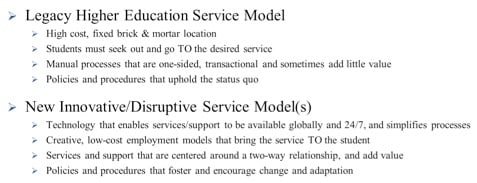Published on
A Model of Innovation and Change: Improving Self-Service and Focusing on Growth

Back in 2009, BYU-Idaho was in the beginnings of expanding their online course offerings. As more courses and programs were offered online and the participation in these programs ballooned, the university quickly recognized the unique service efforts this initiative would require. Initial feedback was that online students were “lost,” and not sure where to go for help. In addition, not all areas of the university were “up-to-speed” on the details and nuances of online and many online students were not familiar with traditional university structures.
These findings helped the university come to a new realization: with no adaptations, traditional campus service structures do not work for online students. In the traditional campus service model the student goes TO the desired service. In the online education service model (and now finding the same expectation and need on traditional campuses) it is critical to flip the paradigm and bring the service TO the student (Figure 1).

Because of this, in January of 2010, BYU-Idaho created the Online Support Center, with a main focus on making the student support experience more seamless for these students at a distance. The Online Support Center (OSC) could serve as a guide/concierge for online students and answer their basic questions and also serve as triage for campus entities, helping students get transferred to the right area on campus.
The original model worked well, but there were still some drawbacks: Students might get one issue resolved in one place, but then need to go two or three other places to finish the process. Because of multiple departments being involved, the university was not quite able to “close the loop” on quality control and customer satisfaction. Lastly, tons of valuable aggregate data was being lost that if captured and analyzed appropriately could lead to necessary improvements in how the university operates.
In May of 2014, President Kim B. Clark (former dean of the Harvard Business School) outlined a new transformational vision (Service Levels) that when paired with the new paradigm of the Online Support Center created an environment that allowed the university to truly actualize his three imperatives of: serving many more and improving the quality of the student experience while lowering relative cost.
At BYU-Idaho, service levels were defined as:
Level 0: Encompasses all the self-service (websites, portals, etc.) and automation that BYU-Idaho has to offer.This touches all departments and is the widest reaching and most encompassing level. Level 0 includes not just services that already exist, but what could be, and what should be, automated or self-service moving forward.
Level 1: Services that do not require specialized expertise. Without specialized expertise, these services can be bundled together in one area to provide a scalable solution that alleviates basic services from Level 2 support personnel. Level 1 should be determined by our Level 2 specialists as they consider what Level 1 support is now, and what it should or could be.
Level 2: Services that require specialized expertise. This should include the processing, in-depth counseling and advising, advanced troubleshooting, and process adjustments. If the service requires a uniquely individual resource, it is Level 2. However, as a service becomes less unique and more standardized, Level 1 and Level 0 should be utilized.
The decision was made to take the online support center model and expand that to all of campus by creating the BYU-Idaho Support Center to serve as both the “front-door” of the university and as the place to bundle all Level One services. This has proven to be a great success on a number of levels.
One of the flaws of a full “one-stop-shop” service office is the natural disconnect from the main functional service areas which in some cases leads to animosity and long-term difficulties with both scope creep and information sharing. The Service Levels design creates an environment where process owners feel an enhanced responsibility as “experts” focusing on the more complex issues, and it allows the university to move more basic tasks down to lower levels of service improving cost efficiency and driving service functionality out to the student.
Even with the Service Levels model we still deal with push-back from some departments who don’t quite understand the need for change. In many cases they are worried about their jobs being “outsourced” to another area, so a concerted effort must be made to help them understand that dividing things out by complexity actually makes them MORE valuable in the long run. Another roadblock we had to overcome was concern over the accuracy of the information we share. We realized we had to dedicate a significant part of our team to consistency and relationships, including tasks such as: centralized hiring and training, scheduled recurring meetings to communicate with departments, maintenance of a centralized Knowledgebase, and quality control processes to overcome this concern.
The most important thing that I can share with others about this type of system is that it is critical to outline all of the advantages as clearly as possible at the outset from multiple perspectives. Bundling and extending the reach of basic support services greatly enhances the student experience. Moving this direction also takes a huge load off of academic and administrative departments that were spending their time answering some of the same basic questions again and again. Consolidation and regular review of this type of information drives the university as a whole towards consistent accurate information and helps identify problems and issues that might otherwise never have been found. This model directly reduces the cost of providing services to customers by adapting and changing how services are delivered (what once cost the school $15 to do, now can be reduced to $2 or even less). This also slows the growth of institutional and departmental financial need by allowing the university to then repurpose those more highly skilled employees to meet higher-level functional work needs.
We’ve been delighted about the progression of this model, as we’ve truly found a way to frame this type of organizational change as a win-win for everyone connected to the institution.
Author Perspective: Administrator



